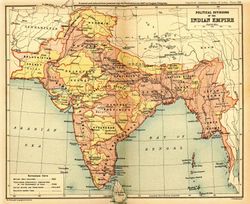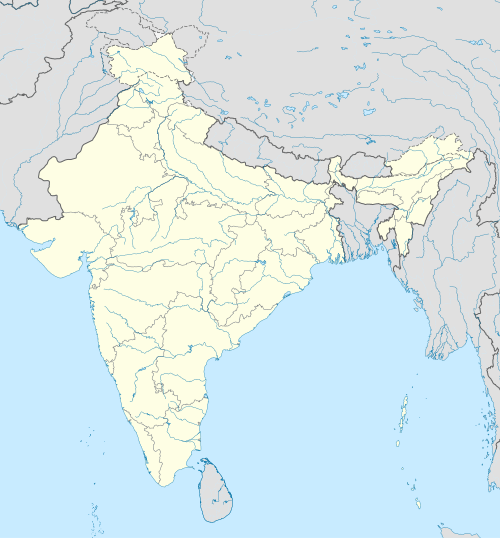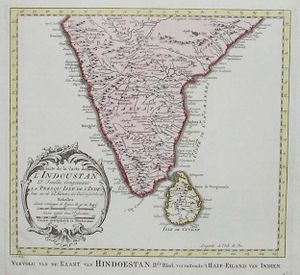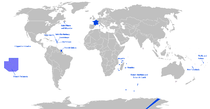الهند الفرنسية
| ||||||||||||||||||||||||||||||||||||||||||||||||||||||||||
الهند الفرنسية French India، هو الاسم الشائع المستخدم للإشارة إلى الممتلكات الفرنسية التي استحوذت عليها شركة الهند الشرقية الفرنسية في الهند منذ النصف الثاني من القرن 17 وما بعدها، والتي تعرف رسمياً باسم Établissements français dans l'Inde ("التأسيسات الفرنسية في الهند") منذ فرض الحكم الفرنسي عام 1816 حتى دمجها بحكم الأمر الواقع إلى اتحاد الهند عام 1947 و1954.[3] وتشمل پودوچري، كاريكال، وياناون على ساحل الكوروماندل، ماهي على ساحل مالابار، وچندرنگور في البنغال. الهند الفرنسية كانت تشمل أيضاً النزل ("النزل"، محطات تجارة فرعية مثل شركات الهند الشرقية الأوروپية التي تأسست في أماكن مختلفة) في بلدات أخرى، لكن بعد 1816 أصبح لتلك النزل أهمية تجارية ضئيلة وأصبحت البلدات تحت الادارة البريطانية.
إجمالي مساحة الهند الفرنسية 510 km2 (200 sq mi)، منها 293 km2 (113 sq mi) كانت تابعة لپودوچري. عام 1936، كان إجمالي سكان المستعمرة 298.851 نسمة، 63% (187.870) منهم كانوا يقيمون في منطقة پودوچري.[4]
. . . . . . . . . . . . . . . . . . . . . . . . . . . . . . . . . . . . . . . . . . . . . . . . . . . . . . . . . . . . . . . . . . . . . . . . . . . . . . . . . . . . . . . . . . . . . . . . . . . . . . . . . . . . . . . . . . . . . . . . . . . . . . . . . . . . . . . . . . . . . . . . . . . . . . . . . . . . . . . . . . . . . . . .
خلفية




France was the last of the major European maritime powers of the 17th century to enter the East India trade. Six decades after the foundation of the English and Dutch East India companies (in 1600 and 1602 respectively), and at a time when both companies were multiplying factories (trading posts) on the shores of India, the French still did not have a viable trading company or a single permanent establishment in the East.
Seeking to explain France's late entrance in the East India trade, historians cite geopolitical circumstances such as the inland position of the French capital, France's numerous internal customs barriers, and parochial perspectives of merchants on France's Atlantic coast, who had little appetite for the large-scale investment required to develop a viable trading enterprise with the distant East Indies.[5][6]
التاريخ
Initial marine voyages to India (16th century)
The first French commercial venture to India is believed to have taken place in the first half of the 16th century, in the reign of King Francis I, when two ships were fitted out by some merchants of Rouen to trade in eastern seas; they sailed from Le Havre and were never heard of again. In 1604, a company was granted letters patent by King Henry IV, but the project failed. Fresh letters patent were issued in 1615, and two ships went to India, only one returning.[7]
La Compagnie française des Indes orientales (French East India Company) was formed under the auspices of Cardinal Richelieu (1642) and reconstructed under Jean-Baptiste Colbert (1664), sending an expedition to Madagascar.[8][9][7]
First factory in India (1668)
In 1667, the French India Company sent out another expedition, under the command of François Caron (who was accompanied by a Persian named Marcara), which reached Surat in 1668 and established the first French factory in India.[8][9]
French expansion in India (1669-1672)
In 1669, Marcara succeeded in establishing another French factory at Masulipatam. In 1672, the French captured Fort Saint Thomas, but they were driven out by the Dutch after a long and costly siege. Chandernagore (present-day Chandannagar) was established in 1692, with the permission of Nawab Shaista Khan, the Mughal governor of Bengal. In 1673, the French acquired the area of Pondicherry from the qiladar of Valikondapuram under the Sultan of Bijapur, and thus the foundation of Pondichéry was laid. By 1720, the French had lost their factories at Surat, Masulipatam and Bantam to the British East India Company.
Establishment of colony at Pondichéry (1673)
On 4 February 1673, Bellanger de l'Espinay, a French officer, took up residence in the Danish Lodge in Pondichéry, thereby commencing the French administration of Pondichéry. In 1674, François Martin, the first Governor, initiated ambitious projects to transform Pondichéry from a small fishing village into a flourishing port-town. However, the French found themselves in continual conflict with the Dutch and the English. In 1693, the Dutch captured Pondichéry and augmented the fortifications. The French regained the town in 1699 through the Treaty of Ryswick, signed on 20 September 1697.
Establishment of colonies at Yanon (1723) and Karaikal (1739)
From their arrival until 1741, the objectives of the French, like those of the British, were purely commercial. During this period, the French East India Company peacefully acquired Yanam (about 840 kilometres or 520 miles north-east of Pondichéry on Andhra Coast) in 1723, Mahe on Malabar Coast in 1725 and Karaikal (about 150 kilometres or 93 miles south of Pondichéry) in 1739. In the early 18th century, the town of Pondichéry was laid out on a grid pattern and grew considerably. Able governors like Pierre Christophe Le Noir (1726–1735) and Pierre Benoît Dumas (1735–1741) expanded the Pondichéry area and made it a large and rich town.
Ambition of establishment of French territorial empire in India and defeat (1741–1754)
Soon after his arrival in 1741, the most famous governor of French India, Joseph François Dupleix, began to hold the ambition of a French territorial empire in India in spite of the pronounced uninterested attitude of his distant superiors and of the French government, which didn't want to provoke the British. Dupleix's ambition clashed with British interests in India and a period of military skirmishes and political intrigues began and continued even in rare periods when France and Great Britain were officially at peace. Under the command of the Marquis de Bussy-Castelnau, Dupleix's army successfully controlled the area between Hyderabad and Cape Comorin. However, Robert Clive, a British officer, arrived in India in 1744, and dashed the hopes of Dupleix to create a French empire in India.
After a defeat and failed peace talks, Dupleix was summarily dismissed and recalled to France in 1754.
French vs British intrigues (1754–1871)
In spite of a treaty between the British and French agreeing not to interfere in regional Indian affairs, their colonial intrigues continued. The French expanded their influence at the court of the Nawab of Bengal and increased their trading activity in Bengal. In 1756, the French encouraged the Nawab (Siraj ud-Daulah) to attack and take the British Fort William in Calcutta. This led to the Battle of Plassey in 1757, where the British decisively defeated the Nawab and his French allies, resulting in the extension of British power over the entire province of Bengal.
Subsequently, France sent Lally-Tollendal to recover the lost French possessions and drive the British out of India. Lally arrived in Pondichéry in 1758, had some initial success and razed Fort St. David in Cuddalore District to the ground in 1758, but strategic mistakes by Lally led to the loss of the Hyderabad region, the Battle of Wandiwash and the siege of Pondicherry in 1760. In 1761, the British razed Pondichéry to the ground in revenge for the French depredations; it lay in ruins for four years. The French had lost their hold now in South India too.
In 1765, Pondichéry was returned to France in accordance with a 1763 peace treaty with Britain. Governor Jean Law de Lauriston set to rebuild the town on its former layout and after five months 200 European and 2000 Tamil houses had been erected. In 1769, the French East India Company, unable to support itself financially, was abolished by the French Crown, which assumed administration of the French possessions in India. During the next 50 years, Pondichéry changed hands between France and Britain with the regularity of their wars and peace treaties.
In 1816, after the conclusion of the Napoleonic Wars, the five establishments of Pondichéry, Chandernagore, Karaikal, Mahe and Yanam and the lodges at Machilipatnam, Kozhikode and Surat were returned to France. Pondichéry had lost much of its former glory, and Chandernagore dwindled into an insignificant outpost to the north of the rapidly growing British metropolis of Calcutta. Successive governors tried, with mixed results, to improve infrastructure, industry, law and education over the next 138 years.
By a decree of 25 January 1871, French India was to have an elective general council (conseil général) and elective local councils (conseil local). The results of this measure were not very satisfactory, and the qualifications for and the classes of the franchise were modified. The governor resided at Pondichéry and was assisted by a council. There were two Tribunaux d'instance (Tribunals of first instance) (at Pondichéry and Karikal) one Cour d'appel (Court of Appeal) (at Pondichéry) and five Juges de paix (Justices of the Peace). Agricultural production consisted of rice, peanuts, tobacco, betel nuts and vegetables.[7]
| ||||||||||||||||||||||||||||||||||||||||||
. . . . . . . . . . . . . . . . . . . . . . . . . . . . . . . . . . . . . . . . . . . . . . . . . . . . . . . . . . . . . . . . . . . . . . . . . . . . . . . . . . . . . . . . . . . . . . . . . . . . . . . . . . . . . . . . . . . . . . . . . . . . . . . . . . . . . . . . . . . . . . . . . . . . . . . . . . . . . . . . . . . . . . . .
Independence movement (18th–20th century) and merger with India (1954)
The Independence of India on 15 August 1947 gave impetus to the union of France's Indian possessions with former British India. The lodges in Machilipatnam, Kozhikode and Surat were ceded to India on 6 October 1947.[10] An agreement between France and India in 1948 agreed to an election in France's remaining Indian possessions to choose their political future. Governance of Chandernagore was ceded to India on 2 May 1950; it was then merged with West Bengal state on 2 October 1954. On 1 November 1954, the four enclaves of Pondichéry, Yanam, Mahe– and Karikal were de facto transferred to the Indian Union and became the Union Territory of Puducherry. The de jure union of French India with India did not take place until 1962 when the French Parliament in Paris ratified the treaty with India.
The myth of "our immense empire in India"
From the mid-19th century onward there developed in France the belief that the five tiny settlements recovered from Britain after the Napoleonic Wars were remnants of the "immense empire" acquired by Dupleix in the 18th century. "Our immense empire of India was reduced to five settlements" wrote French economist and colonial expansion promoter Pierre Paul Leroy-Beaulieu in 1886.[11] An atlas published in the 1930s described those five settlements as "remnants of the great colonial empire that France had created in India in the 18th century".[12] More recently, a historian of French India post-1816 described them as "debris of an empire" and the "last remnants of an immense empire forever lost".[13] However, France never held much more than the five settlements recovered in 1816. The historian of French India and archivist Alfred Martineau, who was also governor of French India, pointed out that the authority granted to Dupleix over the Carnatic in 1750 should not be construed as a transfer of sovereignty, as wrote most historians, given that Dupleix only became so to speak the lieutenant of the Indian subah, who could withdraw his power delegation at his convenience.[14] Philippe Haudrère, historian of the French East India Company, also wrote that Dupleix controlled those territories through a complex system of treaties and alliance, a system almost feudal in nature, but that those territories were neither annexed nor transformed into protectorates.[15]
List of French establishments in India
The French establishments of India are all located in the Indian peninsula. As of 1839, these establishments are[16]
- On the Coramandel coast,
- Pondichéry and its territory comprising districts of Pondichéry, Villenour and Bahour;
- Karikal and its dependent maganams, or districts.
- On the coast of Andhra Pradesh,
- Yanaon and its territory comprising dependent aldées or villages;
- The Masulipatam lodge[note 1] and a garden named Francepeth.[note 2]
- On the Malabar coast,
- In Bengal,
- In Gujarat,
Under the French East India Company's regime, the name 'lodge' was given to factories or insulated establishments consisting of a home with an adjacent ground, where France had the right to fly its flag and form trading posts.
Dupleix meeting the Soudhabar of the Deccan, Murzapha Jung
List of chief governing officers
قائمة حكام الهند الفرنسية
. . . . . . . . . . . . . . . . . . . . . . . . . . . . . . . . . . . . . . . . . . . . . . . . . . . . . . . . . . . . . . . . . . . . . . . . . . . . . . . . . . . . . . . . . . . . . . . . . . . . . . . . . . . . . . . . . . . . . . . . . . . . . . . . . . . . . . . . . . . . . . . . . . . . . . . . . . . . . . . . . . . . . . . .
المفوضون
- François Caron, 1668–72
- François Baron, 1672–81
- فرانسوا مارتان، 1681 – نوفمبر 93
- الاحتلال الهولندي، سبتمبر 1693 – سبتمبر 1699 — معاهدة ريزويك (1697)
الحاكم العام
- François Martin, September 1699 – December 31, 1706
- Pierre Dulivier, January 1707 – July 1708
- Guillaume André d'Hébert, 1708–12
- Pierre Dulivier, 1712–17
- Guillaume André d'Hébert, 1717–18
- Pierre André Prévost de La Prévostière, August 1718 – 11 October 1721
- Pierre Christoph Le Noir (Acting), 1721–23
- Joseph Beauvollier de Courchant, 1723-26
- Pierre Christoph Le Noir, 1726-34
- Pierre Benoît Dumas, 1734-41
- Joseph François Dupleix, January 14, 1742 – October 15, 1754
- Charles Godeheu, Le commissaire (Acting), October 15, 1754-54
- Georges Duval de Leyrit, 1754-58
- Thomas Arthur, comte de Lally, 1758 – January 16, 1761
- First British occupation, January 15, 1761 – June 25, 1765 — معاهدة پاريس (1763)
- Jean Law de Lauriston, 1765-66
- Antoine Boyellau, 1766-67
- Jean Law de Lauriston, 1767 – January 1777
- Guillaume de Bellecombe, seigneur de Teirac, January 1777-82
- Charles Joseph Pâtissier, Marquis de Bussy-Castelnau, 1783-85
- François, Vicomte de Souillac, 1785
- David Charpentier de Cossigny, October 1785-87
- Thomas, comte de Conway, October 1787-89
- Camille Charles Leclerc, chevalier de Fresne,1789-92
- Dominique Prosper de Chermont, November 1792-93
- L. Leroux de Touffreville, 1793
- Second British occupation, August 23, 1793 – 18 June 1802 — معاهدة أميان (1802)
- Charles Matthieu Isidore, Comte Decaen, June 18, 1802 - August 1803
- Louis François Binot, 1803
- Third British occupation, August 1803 – 26 September 1816 — Treaty of Paris (1814)
- André Julien Comte Dupuy, September 26, 1816 – October 1825
- Joseph Cordier, Marie Emmanuel (Acting), October 1825 – June 19, 1826
- Eugène Panon, Comte Desbassayns de Richemont, 1826 – August 2, 1828
- Joseph Cordier, Marie Emmanuel (Acting), August 2, 1828 – April 11, 1829
- Auguste Jacques Nicolas Peureux de Mélay, April 11, 1829 – May 3, 1835
- Hubert Jean Victor, Marquis de Saint-Simon, May 3, 1835 – April 1840
- Paul de Nourquer du Camper, April 1840–44
- Louis Pujol, 1844–49
- Hyacinth Marie de Lalande de Calan, 1849–50
- Philippe Achille Bédier, 1851–52
- Raymond de Saint-Maur, August 1852 – April 1857
- Alexandre Durand d'Ubraye, April 1857 – January 1863
- Napoléon Joseph Louis Bontemps, January 1863 – June 1871
- Antoine-Léonce Michaux, June 1871 – November 1871
- Pierre Aristide Faron, November 1871–75
- Adolph Joseph Antoine Trillard, 1875–1878
- Léonce Laugier, February 1879 – April 1881
- Théodore Drouhet, 1881 – October 1884
- Étienne Richaud, October 1884–86
- Édouard Manès, 1886–88
- Georges Jules Piquet, 1888–89
- Louis Hippolyte Marie Nouet, 1889–91
- Léon Émile Clément-Thomas, 1891–1896
- Louis Jean Girod, 1896 – February 1898
- François Pierre Rodier, February 1898 – January 11, 1902
- Pelletan (Acting), January 11, 1902
- Victor Louis Marie Lanrezac, 1902–04
- Philema Lemaire, August 1904 – April 1905
- Joseph Pascal François, April 1905 – October 1906
- Gabriel Louis Angoulvant, October 1906 – December 3, 1907
- Adrien Jules Jean Bonhoure, 1908–09
- Ernest Fernand Lévecque, 1909 – July 9, 1910
- Alfred Albert Martineau, July 9, 1910 – July 1911
- Pierre Louis Alfred Duprat, July 1911 – November 1913
- Alfred Albert Martineau, November 1913 – June 29, 1918
- (unknown), June 29, 1918 – February 21, 1919
- Louis Martial Innocent Gerbinis, February 21, 1919 – February 11, 1926
- Henri Leo Eugene Lagroua (Acting), February 11, 1926 – August 5, 1926
- Pierre Jean Henri Didelot, 1926-28
- Robert Paul Marie de Guise, 1928-31
- François Adrien Juvanon, 1931-34
- Léon Solomiac, August 1934–36
- Horace Valentin Crocicchia, 1936–38
- Louis Alexis Étienne Bonvin, September 26, 1938-45
- Nicolas Ernest Marie Maurice Jeandin, 1945-46
- Charles François Marie Baron, March 20, 1946 – August 20, 1947
French India became a Territoire d'outre-mer of France in 1946.
المفوضون
- Charles François Marie Baron, August 20, 1947 – May 1949
- Charles Chambon, May 1949 – July 31, 1950
- André Ménard, July 31, 1950 – October 1954
- Georges Escargueil, October 1954 – November 1, 1954
de facto transfer to Indian Union
المندوب السامي
- Mr.Kewal Singh November 1, 1954-57
- M.K. Kripalani 1957-58
- L.R.S. Singh 1958-58
- AS Bam 1960
- Sarat Kumar Dutta 1961-61
انظر أيضاً
- أسباب تحرير المستعمرات الفرنسية في الهند
- ادارة البلديات في الهند الفرنسية
- المستعمرات الأوروپية في الهند
- انقلاب يناون
- الامبراطورية الاستعمارية الفرنسية
- چاند صاحب
- مظفر جانگ
- صلابت جانگ
- كلود مارتين
- La Martiniere College
- قائمة الممتلكات والمستعمرات الفرنسية
الهوامش ولمصادر
- تحوي هذه المقالة معلومات مترجمة من الطبعة الحادية عشرة لدائرة المعارف البريطانية لسنة 1911 وهي الآن من ضمن الملكية العامة.
- ^ as Commissioner
- ^ as High Commissioner
- ^ In France, the official name was customarily used in official documents; the expression Inde française was generally not used as it seemed too grandiose, inasmuch as the Indian territory under French administration was minuscule, especially in comparison to to British India. Among the French population and in the French press, the expression Comptoirs de l'Inde was commonly used. Properly speaking, though, a comptoir is a trading station, whereas the French possessions in India comprehended entire towns and were not mere trading stations.
- ^ Jacques Weber, Pondichéry et les comptoirs de l'Inde après Dupleix, Éditions Denoël, Paris, 1996, p. 347.
- ^ Holden Furber, Rival Empires of Trade in the Orient, 1600–1800, University of Minnesota Press, 1976, p. 201.
- ^ Philippe Haudrère, Les Compagnies des Indes Orientales, Paris, 2006, p 70.
- ^ أ ب ت One or more of the preceding sentences incorporates text from a publication now in the public domain: Chisholm, Hugh, ed. (1911). . دائرة المعارف البريطانية. Vol. 14 (eleventh ed.). Cambridge University Press. p. 421.
{{cite encyclopedia}}: Cite has empty unknown parameter:|coauthors=(help) - ^ أ ب Lach, Donald Frederick (1998), Asia in the making of Europe, University of Chicago Press, p. 747, ISBN 9780226467672, https://books.google.com/books?id=qBZg0OhbiXMC&pg=PA747.
- ^ أ ب Benians, Ernest Alfred; Newton, Arthur Percival; Rose, John Holland (1940), The Cambridge history of the British Empire, p. 66, https://books.google.com/books?id=Y-08AAAAIAAJ&pg=PA66.
- ^ Accord par échange de lettres relatif à la date de la cession des anciennes loges françaises de l'Inde au gouvernement de l'Inde [Agreement by exchange of letters relating to the date of the cession of the former French lodges of India to the Government of India] (in French). Paris: Ministère de l'Europe et des Affaires étrangères. 1947. p. 5. Retrieved 2 September 2022.
the Government of India note and accept with pleasure the decision of the Government of France that October 6th will be the day from which the historic rights which France has exercised in the areas known as the French Loges in India will be renounced.
{{cite book}}: CS1 maint: unrecognized language (link) - ^ Paul Leroy-Beaulieu, De la colonisation chez les peuples modernes, Librairie Guillaumin et Cie (2nd edition, 1886), p. vi
- ^ Kathryn Dale, France’s Lost Empires. Fragmentation, Nostalgia and la fracture coloniale, edited by Kate Marsh and Nicola Frith, Lexington Books, (2010) p. 37
- ^ Jacques Weber, Les établissements français en Inde au XIXe siècle (1816-1914), Librairie de l'Inde Éditeur (1988), p. 24-25
- ^ "Elle n'entraînait pas le droit de l'exercice de la souveraineté, ainsi que l'ont écrit presque tous les historiens; Dupleix ne devenant en réalité que le lieutenant, ou naëb, du soubab; celui-ci conservait le pouvoir éminent et pouvait à sa convenance retirer sa délégation" Alfred Martineau, Dupleix, sa vie et son œuvre, Société d'éditions géographiques, maritimes et coloniales (Paris 1931) p. 168-169
- ^ "Dupleix mène une grande politique visant à contrôler un vaste territoire, il s'agit bien de contrôle et non d'annexion, ni même de protectorat; c’est un ensemble compliqué reposant sur une série de traités et d'alliances et sur l'installation de garnisons commandées par des officiers français. [...] C'est un système très souple de caractère presque féodal" Philippe Haudrère, Présence française en Inde et dans l’Océan indien, in Présences françaises outre-mer (XVIe-XXIe siècles), Philippe Bonichon et al., Karthala (2012), tome 1, p. 245
- ^ Chapitre II, Notices statistiques sur les colonies françaises, 1839.
- ^ Thomas Bowrey (1993). A Geographical Account of Countries Round the Bay of Bengal, 1669 to 1679. Asian Educational Services. ISBN 9788120608481.
- ^ Claude Markovits (2004). A History of Modern India, 1480-1950. Anthem Press. p. 210. ISBN 9781843311522.
المراجع
- Sudipta Das (1992). Myths and realities of French imperialism in India, 1763–1783. New York: P. Lang. ISBN 0820416762. 459p.
وصلات خارجية
| French India
]].- French Books on India: Representations of India in French Literature and Culture 1750 to 1962 – University of Liverpool
- V. Sankaran, Freedom struggle in Pondicherry – Gov't of India publication
خطأ استشهاد: وسوم <ref> موجودة لمجموعة اسمها "note"، ولكن لم يتم العثور على وسم <references group="note"/>
- مقالات المعرفة المحتوية على معلومات من دائرة المعارف البريطانية طبعة 1911
- Wikipedia articles incorporating text from the 1911 Encyclopædia Britannica
- Short description is different from Wikidata
- Pages using infobox country or infobox former country with the symbol caption or type parameters
- Articles with hatnote templates targeting a nonexistent page
- مقالات مأخوذة من الطبعة الحادية عشرة لدائرة المعارف البريطانية
- انحلالات 1954
- الهند الفرنسية
- بلدان سابقة في جنوب آسيا
- دول ومناطق تأسست في 1769
- كرالا الإستعمارية
- العلاقات الفرنسية الهندية
- مستعمرات سابقة في آسيا

























